人教版高中英语必修第一册Unit4 Natural disasters SectionⅢ Discovering Useful Structures课件
文档属性
| 名称 | 人教版高中英语必修第一册Unit4 Natural disasters SectionⅢ Discovering Useful Structures课件 | 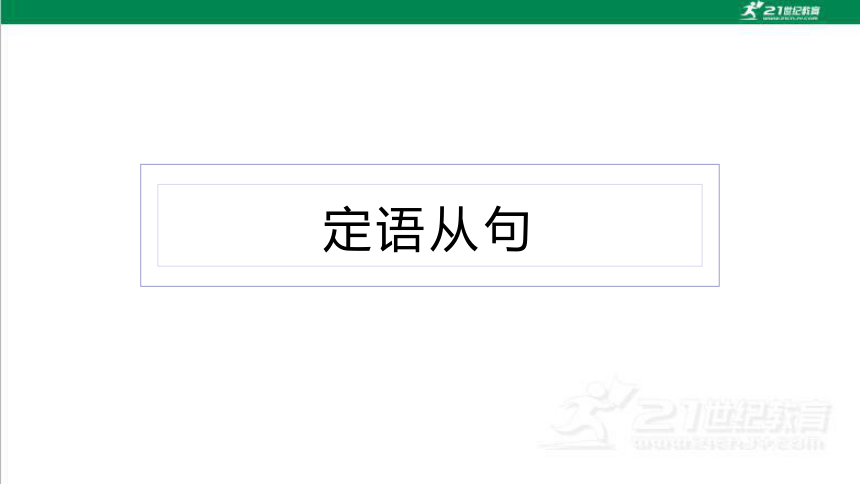 | |
| 格式 | ppt | ||
| 文件大小 | 5.8MB | ||
| 资源类型 | 试卷 | ||
| 版本资源 | 人教版(2019) | ||
| 科目 | 英语 | ||
| 更新时间 | 2025-07-16 15:35:05 | ||
图片预览

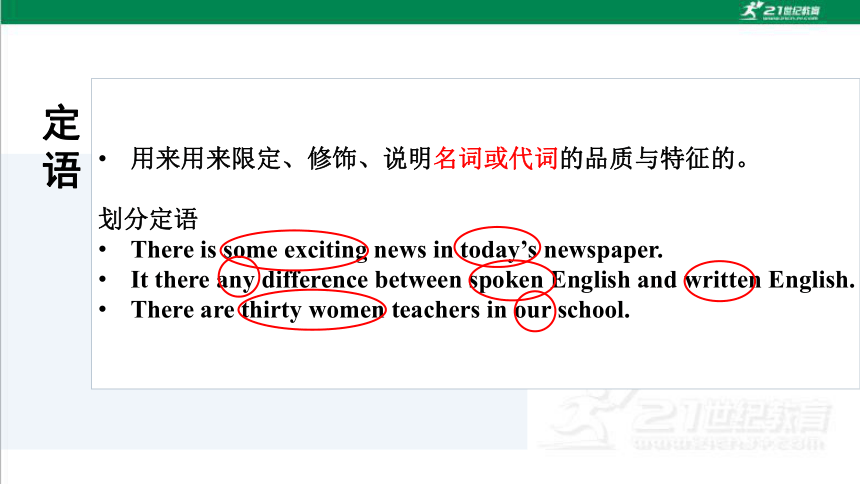
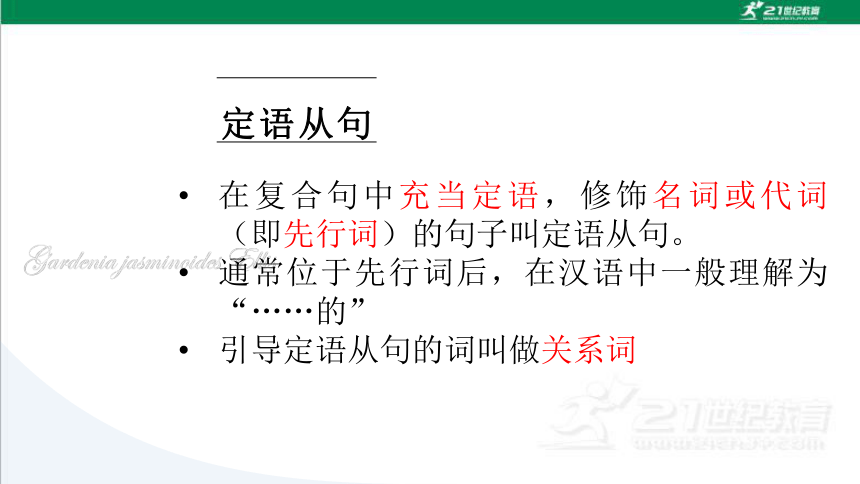
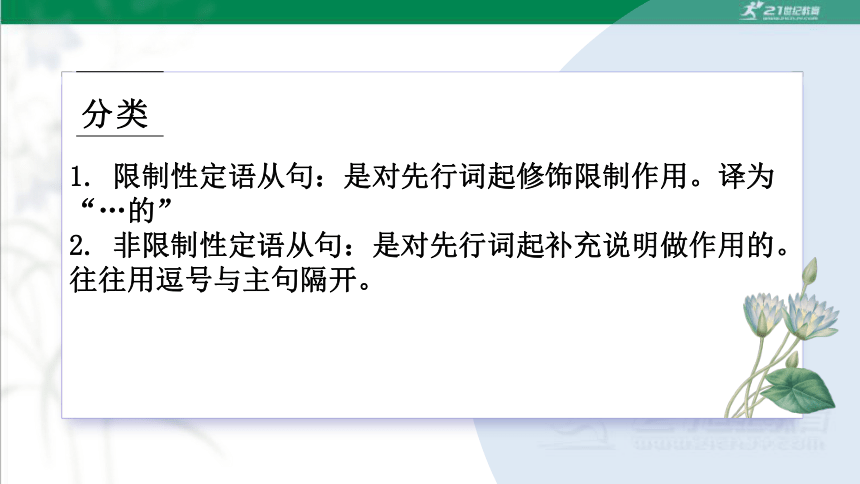
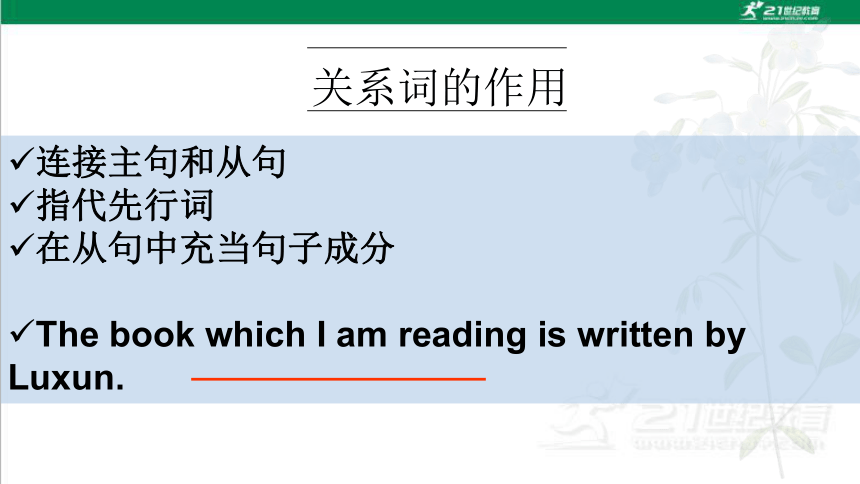
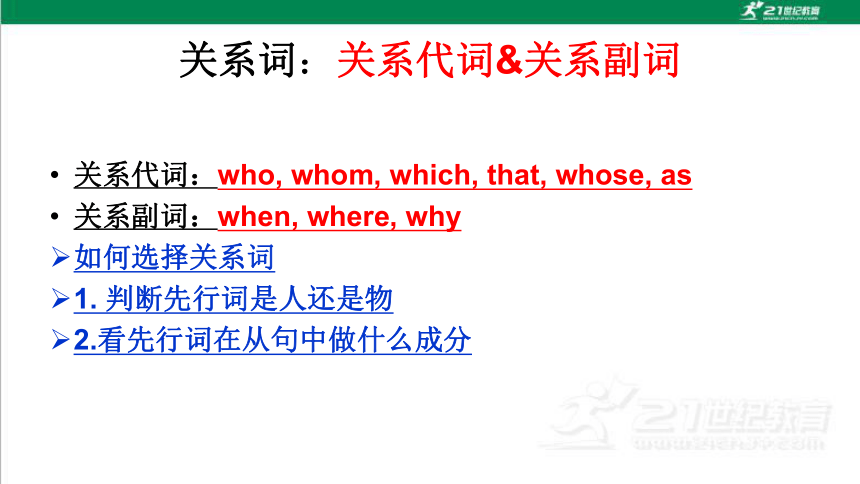
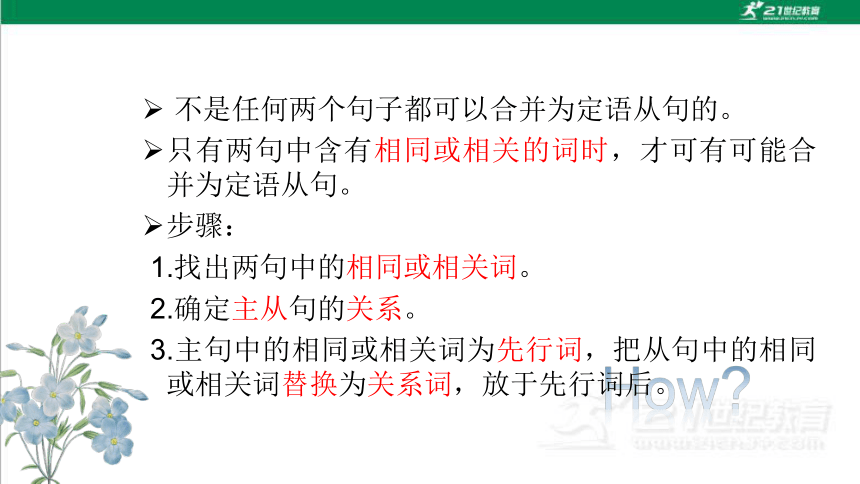
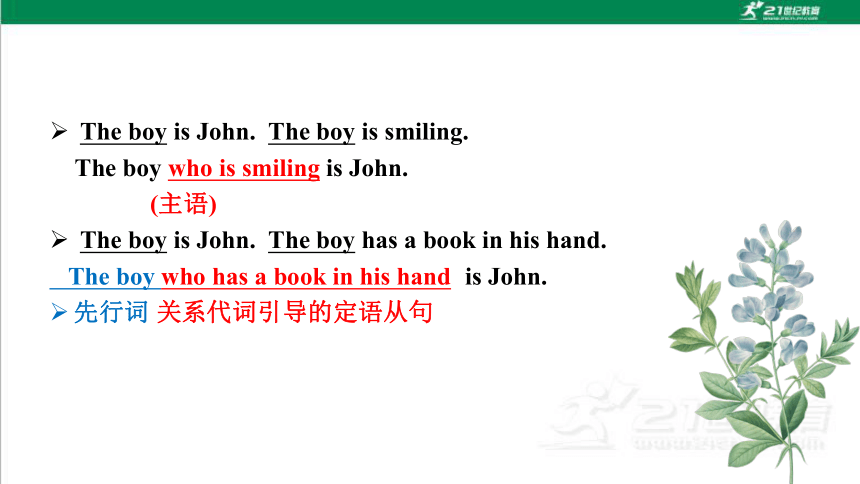
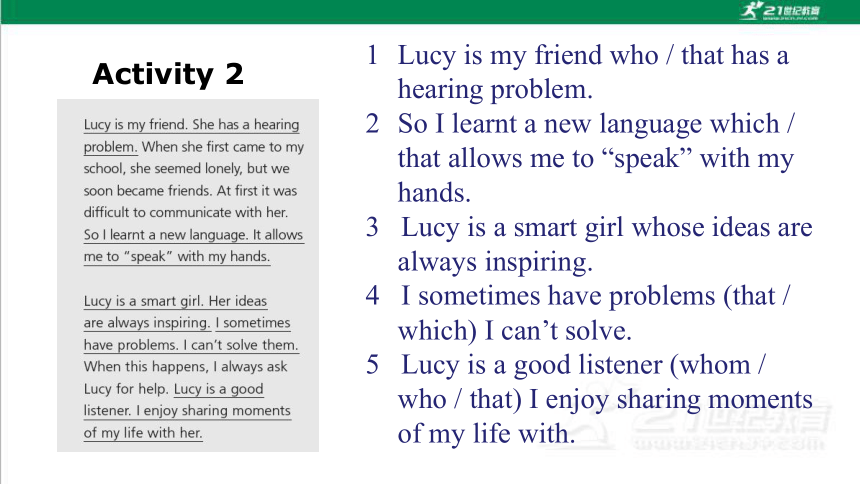
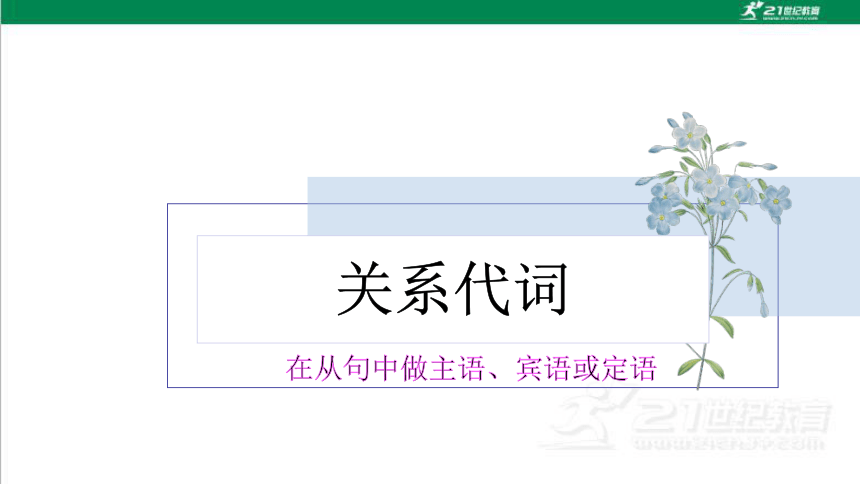
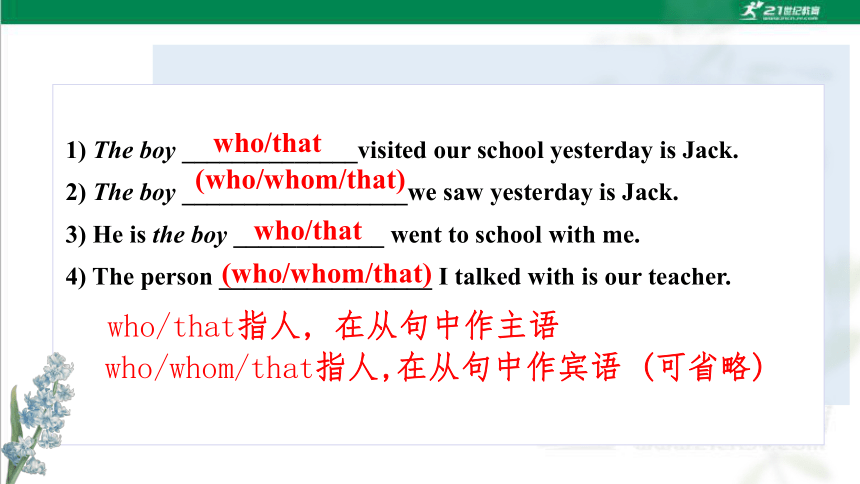
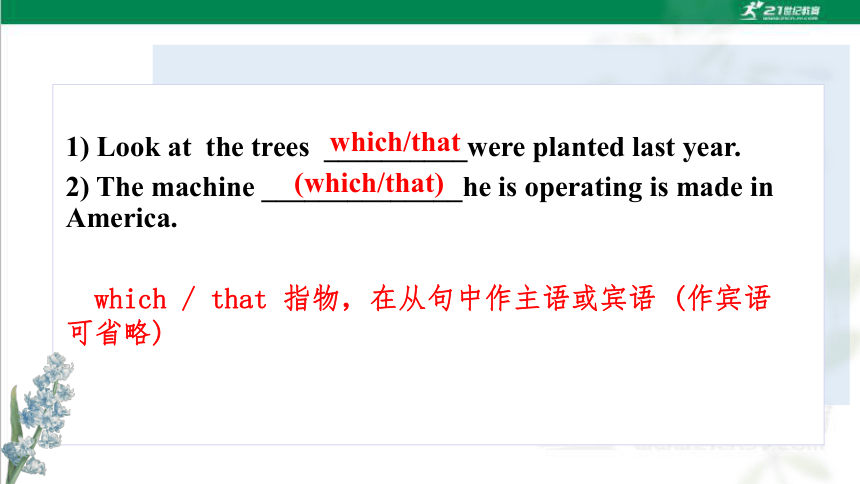
文档简介
(共42张PPT)
定语从句
定语
用来用来限定、修饰、说明名词或代词的品质与特征的。
划分定语
There is some exciting news in today’s newspaper.
It there any difference between spoken English and written English.
There are thirty women teachers in our school.
在复合句中充当定语,修饰名词或代词(即先行词)的句子叫定语从句。
通常位于先行词后,在汉语中一般理解为“……的”
引导定语从句的词叫做关系词
定语从句
沉分类默
1. 限制性定语从句:是对先行词起修饰限制作用。译为“…的”
2. 非限制性定语从句:是对先行词起补充说明做作用的。往往用逗号与主句隔开。
分类
连接主句和从句
指代先行词
在从句中充当句子成分
The book which I am reading is written by Luxun.
关系词的作用
关系词:关系代词&关系副词
关系代词:who, whom, which, that, whose, as
关系副词:when, where, why
如何选择关系词
1. 判断先行词是人还是物
2.看先行词在从句中做什么成分
不是任何两个句子都可以合并为定语从句的。
只有两句中含有相同或相关的词时,才可有可能合并为定语从句。
步骤:
1.找出两句中的相同或相关词。
2.确定主从句的关系。
3.主句中的相同或相关词为先行词,把从句中的相同或相关词替换为关系词,放于先行词后。
The boy is John. The boy is smiling.
The boy who is smiling is John.
(主语)
The boy is John. The boy has a book in his hand.
The boy who has a book in his hand is John.
先行词 关系代词引导的定语从句
Activity 2
Lucy is my friend who / that has a hearing problem.
So I learnt a new language which / that allows me to “speak” with my hands.
3 Lucy is a smart girl whose ideas are always inspiring.
4 I sometimes have problems (that / which) I can’t solve.
5 Lucy is a good listener (whom / who / that) I enjoy sharing moments of my life with.
1) The boy ______________visited our school yesterday is Jack.
2) The boy __________________we saw yesterday is Jack.
3) He is the boy ____________ went to school with me.
4) The person _________________ I talked with is our teacher.
who/that
(who/whom/that)
who/that
(who/whom/that)
who/that指人, 在从句中作主语
who/whom/that指人,在从句中作宾语 (可省略)
1) Look at the trees __________were planted last year.
2) The machine ______________he is operating is made in America.
which/that
(which/that)
which / that 指物,在从句中作主语或宾语 (作宾语可省略)
1) Harry is the boy mother is our Maths teacher.
2) Look at the tree leaves are black.
3) He helped the man _______car had broken.
4) He lives in a house ________windows open south.
whose
whose
whose
whose
whose : 指人或物,在从句中作定语,表示所属关系,译为“…的”
The house is mine. The window of the house is broken.
1)The house whose window is broken is mine.
whose=the house’s window
2)The house the window of which is broken is mine
3)The house of which the window is broken is mine
关系代词常用 that 不用which的情况
1. 先行词为everything, anything, nothing, little, much, all, few, none等不定代词或者被其修饰。
All (that) you have done is helpful to us.
2. 先行词前有形容词最高级、序数词修饰时
That is the first film that was directed by him.
3. 先行词被the only, the very, the last 修饰时。
He is the only person that I want to see now.
4. 先行词同时指人和指物时。
We talked about the things and persons that we saw then.
5. who , which 引导的句子中避免混淆时
Who is the man that is standing over there
不用that ,用which的情况
which
which
summary
关系代词 指代 成分
that 人/物 主语/宾语
which 物 主语/宾语
who 人 主语/宾语
whom 人 宾语
whose 人/物 定语
一. 关系代词作宾语通常省去。
The day (that) we were looking forward to came finally.
The house (that) he had had had been taken away from him by the time he returned to his country.
He did everything (that) he could (do) to help the orphan.
注意 下列两种情况不可省去。
1. 非限制性定语从句中
试比较
This is the city (which/that) I visited five years ago
This is the city, which I visited five years ago.
2. 介词前置时
试比较:
This is a book (that /which) we can learn a lot from.
This is a book from which we can learn a lot.
prep+ whom/ which
若引导词作介词的宾语,介词可以提前构成介词+引导词的形式
介词的选择主要取决于 (1)先行词的需要
(2)从句谓语的需要
Is this the library _____ you borrow books from
Is this the library __________ you borrow books
The man (whom) I nodded to is Mr. Li.
The man ________ I nodded is Mr. Li.
which
from which
to whom
介词+关系代词
用 介词+which
1. Do you like the book she spent $10
2. Do you like the book she paid $10
3. Do you like the book she learned a lot
4. Do you like the book she often talks
on which
for which
from which
about which
5. There is a tall tree outside, ___________ stands our teacher.
6. China has a lot of rivers, the second longest _______ is the Yellow River.
7. The man ________ I spoke on the phone last night is very good at wrestling
8. He paid the boy $10 for washing ten windows, most ________ hadn’t been cleaned for at least a year.
under which
of which
to whom
of which
There are two boys in Peters,both of ____ are white.
There are two boys in Peter’s, and both of ______ are white.
There are two boys in Peter’s; both of ______ are white.
易混淆句型
whom
them
them
关系副词-从句中做状语
Sentences in the passage:
1 If this works, there may come a time when the number of monarch butterflies increased once again.
2 In many places where the butterfly can be found
3 Human activity is the main reason why the number of monarch butterfly is falling.
关系副词的用法
关系副词 指代 在从句中的作用
when
where
why
时间
时间状语
地点
地点状语
原因
原因状语
关系副词when, where, why可以用适当的介词+which来替代。
when=in/on/at/during…+which,
where=in/on/at…+which,
why=for which
I will never forget the day. We went to the factory on that day.
I will never forget the day on which we went to the factory.
I will never forget the day when we went to the factory.
Do you know the factory My friend worked in the factory five years ago.
Do you know the factory in which my friend worked five years ago
Do you know the factory where my friend worked five years ago
This is the reason. He left home for it.
This is the reason for which he left home.
This is the reason why he left home.
I don’t like his way. He usually treat others in the way.
I don’t like his way in which he usually treat others .
I don’t like his way that he usually treat others .
I don’t like his way * he usually treat others.
当介词+which引导定语从句时,有时可以用关系副词 when /where/why
1.This is the room ____________ I visited yesterday.
This is the room_________________ I left the book yesterday.
2.I will remember the days ___________ we spent together.
I will remember the days ______________ we stayed together.
3.This is the reason____________ I gave to the teacher.
This is the reason _______________ I was late yesterday.
4. I have a good way _____________ he told me.
I have a good way ______________ we can solve the problem quickly.
(which/that)
where/in which
(which/that)
when/in which
(which/that)
why/for which
(which/that)
in which/that/*
1). I’ve come to the point where I can’t stand him.
2). The country is in the situation where a war will break out at any time.
我已经到了无法容忍他的地步了。
国家正处在随时有可能爆发战争的局势中。
先行词是抽象的地点,用关系副词where引导。
如果定语从句分别修饰point, situation, stage, condition, case, position等表示“情况,状况,形势”等抽象意义的词,常用where 引导,意思是“到了某种地步,在某种境况中” 。
代替一个句子 (正如,正像…那样)
从句位置可置于主句之前或之后,有时也可作为插入语置于句中,一般用逗号和主句隔开。
as we can see, as is mentioned above, as is known to all, as we all know等。
As is well known,great changes have taken place in China.
Great changes, as is well known, have taken place in China.
He failed in the exam again, as was expected
( as在定语从句中作主语)
As
下列固定结构,如:
1 as has been said before 如前所述
2 as often happens 正像经常发生的那样
3 as is well known= as is known to all 众所周知
4 as we have expected正如我们预料的那样
5 as has been mentioned above正如上面提到的
6 as we can see 正如大家看到的那样
2.which引导非限制性定语从句,代替前面出现的句子。
(语意上常表示这一点,这一方面或一定的因果关系)
The result of the experiment was very good, which we hadn’t expected.
Bamboo is hollow, which makes it very light.
The weather turned out to be very good, which was more than we could expect.
which 和 as (代替句子)的用法区别:
(1)语意上的区别
The result of the experiment was very good, _____ we hadn't expected.
The result of the experiment was very good, ___we had expected.
which
as
(2) 形式上的区别:as 的句子可以在不同的地方使用,而which的句子只能放在后面。
As is well known,great changes have taken place in China.
Great changes, as is well known, have taken place in China.
Great changes have taken place in China, as is well known.
The elephant is like a spear, as anybody can see.
Great progress have been made in China, which makes us proud.
as引导定语从句
1. as 作关系代词,在从句中作主语、宾语、表语。
(1)当such或the same修饰先行词时,as不能省略
Such books as you gave me are interesting.
He wore the same uniform ___ his classmates have.
He wore the same uniform _____ his friend lent him .
(as表示同一类,that表示同一个)
as
that
当先行词与so连用时,关系代词用as.
注意so/such…as 与 so/such…that 的区别
It is so big a stone/such a big stone _____I can’t move.
It is so big a stone/such a big stone ____ I can’t move it.
This is such a difficult problem ______ I can’t lift.
This is such a difficult problem ______ I can’t lift it.
as
that
as
that
He is one of the students who _______ praised.
He is the one of the students who ______ praised.
He is one of the teachers who _______ playing baseball. (like)
He is the only one of the teachers who _______ playing baseball. (like)
John is one of the students who_______ English. (know)
John is the only one of the students who _______ English.
like
likes
were
was
know
knows
One of ,和 the (very, only)one of, one of… 表示…中的一个,从句谓语用复数,而the (only, very )one of…表示……中的唯一的一个,从句谓语用单数。
强调句句型:It is/was +被强调的成份+that/who +其它部分.去掉 It is/was….that/who… ,句子依然成立;
定语从句的引导词在句中要作一成份。
(1) It is in this room _____I lived last year.
It is the room ______I lived last year.
(2) It was at seven o’clock _____he went to school this morning.
It was seven o’clock _____he went to school this morning.
that
where
that
when
强调句与定语从句
定语从句和同位语从句
(1)The news ________our volleyball team won the match made us excited.
(2)The news _________he told me yesterday is exciting.
(3)The problem __________we should answer for the accident is clear to you.
(4)The problem __________he wanted to solve is hard.
that 引导同位语从句,在从句中不充当任成分,并且引导的句子是解释说明前一名词的内容,在从句中不可省去,也不可用which 替代。
that/which 引导定语从句,在从句中充当成分,作宾语时可省去,从句起说明主句性质和特征的作用。
that
that/which
that
that/which
定语从句
定语
用来用来限定、修饰、说明名词或代词的品质与特征的。
划分定语
There is some exciting news in today’s newspaper.
It there any difference between spoken English and written English.
There are thirty women teachers in our school.
在复合句中充当定语,修饰名词或代词(即先行词)的句子叫定语从句。
通常位于先行词后,在汉语中一般理解为“……的”
引导定语从句的词叫做关系词
定语从句
沉分类默
1. 限制性定语从句:是对先行词起修饰限制作用。译为“…的”
2. 非限制性定语从句:是对先行词起补充说明做作用的。往往用逗号与主句隔开。
分类
连接主句和从句
指代先行词
在从句中充当句子成分
The book which I am reading is written by Luxun.
关系词的作用
关系词:关系代词&关系副词
关系代词:who, whom, which, that, whose, as
关系副词:when, where, why
如何选择关系词
1. 判断先行词是人还是物
2.看先行词在从句中做什么成分
不是任何两个句子都可以合并为定语从句的。
只有两句中含有相同或相关的词时,才可有可能合并为定语从句。
步骤:
1.找出两句中的相同或相关词。
2.确定主从句的关系。
3.主句中的相同或相关词为先行词,把从句中的相同或相关词替换为关系词,放于先行词后。
The boy is John. The boy is smiling.
The boy who is smiling is John.
(主语)
The boy is John. The boy has a book in his hand.
The boy who has a book in his hand is John.
先行词 关系代词引导的定语从句
Activity 2
Lucy is my friend who / that has a hearing problem.
So I learnt a new language which / that allows me to “speak” with my hands.
3 Lucy is a smart girl whose ideas are always inspiring.
4 I sometimes have problems (that / which) I can’t solve.
5 Lucy is a good listener (whom / who / that) I enjoy sharing moments of my life with.
1) The boy ______________visited our school yesterday is Jack.
2) The boy __________________we saw yesterday is Jack.
3) He is the boy ____________ went to school with me.
4) The person _________________ I talked with is our teacher.
who/that
(who/whom/that)
who/that
(who/whom/that)
who/that指人, 在从句中作主语
who/whom/that指人,在从句中作宾语 (可省略)
1) Look at the trees __________were planted last year.
2) The machine ______________he is operating is made in America.
which/that
(which/that)
which / that 指物,在从句中作主语或宾语 (作宾语可省略)
1) Harry is the boy mother is our Maths teacher.
2) Look at the tree leaves are black.
3) He helped the man _______car had broken.
4) He lives in a house ________windows open south.
whose
whose
whose
whose
whose : 指人或物,在从句中作定语,表示所属关系,译为“…的”
The house is mine. The window of the house is broken.
1)The house whose window is broken is mine.
whose=the house’s window
2)The house the window of which is broken is mine
3)The house of which the window is broken is mine
关系代词常用 that 不用which的情况
1. 先行词为everything, anything, nothing, little, much, all, few, none等不定代词或者被其修饰。
All (that) you have done is helpful to us.
2. 先行词前有形容词最高级、序数词修饰时
That is the first film that was directed by him.
3. 先行词被the only, the very, the last 修饰时。
He is the only person that I want to see now.
4. 先行词同时指人和指物时。
We talked about the things and persons that we saw then.
5. who , which 引导的句子中避免混淆时
Who is the man that is standing over there
不用that ,用which的情况
which
which
summary
关系代词 指代 成分
that 人/物 主语/宾语
which 物 主语/宾语
who 人 主语/宾语
whom 人 宾语
whose 人/物 定语
一. 关系代词作宾语通常省去。
The day (that) we were looking forward to came finally.
The house (that) he had had had been taken away from him by the time he returned to his country.
He did everything (that) he could (do) to help the orphan.
注意 下列两种情况不可省去。
1. 非限制性定语从句中
试比较
This is the city (which/that) I visited five years ago
This is the city, which I visited five years ago.
2. 介词前置时
试比较:
This is a book (that /which) we can learn a lot from.
This is a book from which we can learn a lot.
prep+ whom/ which
若引导词作介词的宾语,介词可以提前构成介词+引导词的形式
介词的选择主要取决于 (1)先行词的需要
(2)从句谓语的需要
Is this the library _____ you borrow books from
Is this the library __________ you borrow books
The man (whom) I nodded to is Mr. Li.
The man ________ I nodded is Mr. Li.
which
from which
to whom
介词+关系代词
用 介词+which
1. Do you like the book she spent $10
2. Do you like the book she paid $10
3. Do you like the book she learned a lot
4. Do you like the book she often talks
on which
for which
from which
about which
5. There is a tall tree outside, ___________ stands our teacher.
6. China has a lot of rivers, the second longest _______ is the Yellow River.
7. The man ________ I spoke on the phone last night is very good at wrestling
8. He paid the boy $10 for washing ten windows, most ________ hadn’t been cleaned for at least a year.
under which
of which
to whom
of which
There are two boys in Peters,both of ____ are white.
There are two boys in Peter’s, and both of ______ are white.
There are two boys in Peter’s; both of ______ are white.
易混淆句型
whom
them
them
关系副词-从句中做状语
Sentences in the passage:
1 If this works, there may come a time when the number of monarch butterflies increased once again.
2 In many places where the butterfly can be found
3 Human activity is the main reason why the number of monarch butterfly is falling.
关系副词的用法
关系副词 指代 在从句中的作用
when
where
why
时间
时间状语
地点
地点状语
原因
原因状语
关系副词when, where, why可以用适当的介词+which来替代。
when=in/on/at/during…+which,
where=in/on/at…+which,
why=for which
I will never forget the day. We went to the factory on that day.
I will never forget the day on which we went to the factory.
I will never forget the day when we went to the factory.
Do you know the factory My friend worked in the factory five years ago.
Do you know the factory in which my friend worked five years ago
Do you know the factory where my friend worked five years ago
This is the reason. He left home for it.
This is the reason for which he left home.
This is the reason why he left home.
I don’t like his way. He usually treat others in the way.
I don’t like his way in which he usually treat others .
I don’t like his way that he usually treat others .
I don’t like his way * he usually treat others.
当介词+which引导定语从句时,有时可以用关系副词 when /where/why
1.This is the room ____________ I visited yesterday.
This is the room_________________ I left the book yesterday.
2.I will remember the days ___________ we spent together.
I will remember the days ______________ we stayed together.
3.This is the reason____________ I gave to the teacher.
This is the reason _______________ I was late yesterday.
4. I have a good way _____________ he told me.
I have a good way ______________ we can solve the problem quickly.
(which/that)
where/in which
(which/that)
when/in which
(which/that)
why/for which
(which/that)
in which/that/*
1). I’ve come to the point where I can’t stand him.
2). The country is in the situation where a war will break out at any time.
我已经到了无法容忍他的地步了。
国家正处在随时有可能爆发战争的局势中。
先行词是抽象的地点,用关系副词where引导。
如果定语从句分别修饰point, situation, stage, condition, case, position等表示“情况,状况,形势”等抽象意义的词,常用where 引导,意思是“到了某种地步,在某种境况中” 。
代替一个句子 (正如,正像…那样)
从句位置可置于主句之前或之后,有时也可作为插入语置于句中,一般用逗号和主句隔开。
as we can see, as is mentioned above, as is known to all, as we all know等。
As is well known,great changes have taken place in China.
Great changes, as is well known, have taken place in China.
He failed in the exam again, as was expected
( as在定语从句中作主语)
As
下列固定结构,如:
1 as has been said before 如前所述
2 as often happens 正像经常发生的那样
3 as is well known= as is known to all 众所周知
4 as we have expected正如我们预料的那样
5 as has been mentioned above正如上面提到的
6 as we can see 正如大家看到的那样
2.which引导非限制性定语从句,代替前面出现的句子。
(语意上常表示这一点,这一方面或一定的因果关系)
The result of the experiment was very good, which we hadn’t expected.
Bamboo is hollow, which makes it very light.
The weather turned out to be very good, which was more than we could expect.
which 和 as (代替句子)的用法区别:
(1)语意上的区别
The result of the experiment was very good, _____ we hadn't expected.
The result of the experiment was very good, ___we had expected.
which
as
(2) 形式上的区别:as 的句子可以在不同的地方使用,而which的句子只能放在后面。
As is well known,great changes have taken place in China.
Great changes, as is well known, have taken place in China.
Great changes have taken place in China, as is well known.
The elephant is like a spear, as anybody can see.
Great progress have been made in China, which makes us proud.
as引导定语从句
1. as 作关系代词,在从句中作主语、宾语、表语。
(1)当such或the same修饰先行词时,as不能省略
Such books as you gave me are interesting.
He wore the same uniform ___ his classmates have.
He wore the same uniform _____ his friend lent him .
(as表示同一类,that表示同一个)
as
that
当先行词与so连用时,关系代词用as.
注意so/such…as 与 so/such…that 的区别
It is so big a stone/such a big stone _____I can’t move.
It is so big a stone/such a big stone ____ I can’t move it.
This is such a difficult problem ______ I can’t lift.
This is such a difficult problem ______ I can’t lift it.
as
that
as
that
He is one of the students who _______ praised.
He is the one of the students who ______ praised.
He is one of the teachers who _______ playing baseball. (like)
He is the only one of the teachers who _______ playing baseball. (like)
John is one of the students who_______ English. (know)
John is the only one of the students who _______ English.
like
likes
were
was
know
knows
One of ,和 the (very, only)one of, one of… 表示…中的一个,从句谓语用复数,而the (only, very )one of…表示……中的唯一的一个,从句谓语用单数。
强调句句型:It is/was +被强调的成份+that/who +其它部分.去掉 It is/was….that/who… ,句子依然成立;
定语从句的引导词在句中要作一成份。
(1) It is in this room _____I lived last year.
It is the room ______I lived last year.
(2) It was at seven o’clock _____he went to school this morning.
It was seven o’clock _____he went to school this morning.
that
where
that
when
强调句与定语从句
定语从句和同位语从句
(1)The news ________our volleyball team won the match made us excited.
(2)The news _________he told me yesterday is exciting.
(3)The problem __________we should answer for the accident is clear to you.
(4)The problem __________he wanted to solve is hard.
that 引导同位语从句,在从句中不充当任成分,并且引导的句子是解释说明前一名词的内容,在从句中不可省去,也不可用which 替代。
that/which 引导定语从句,在从句中充当成分,作宾语时可省去,从句起说明主句性质和特征的作用。
that
that/which
that
that/which
